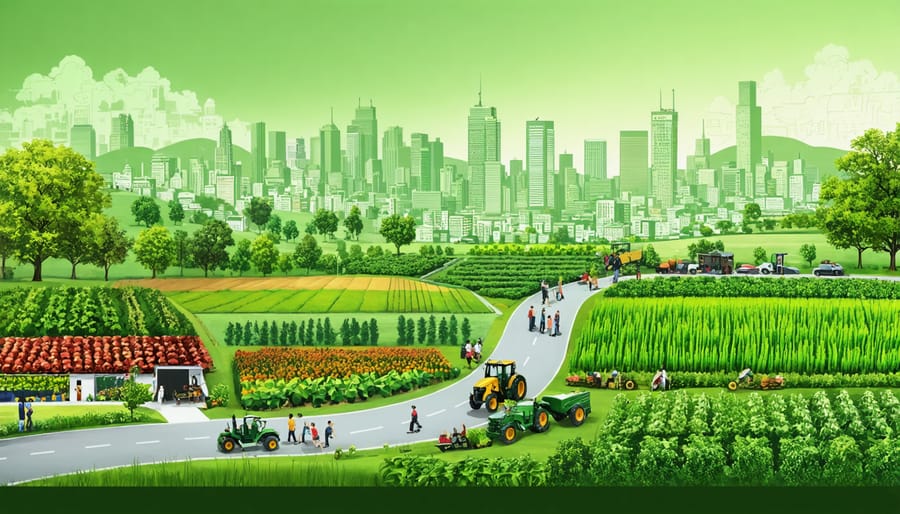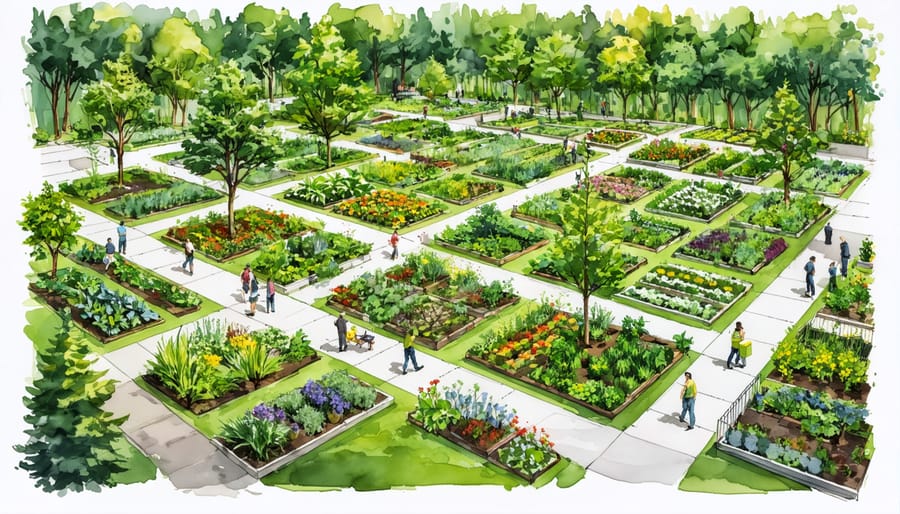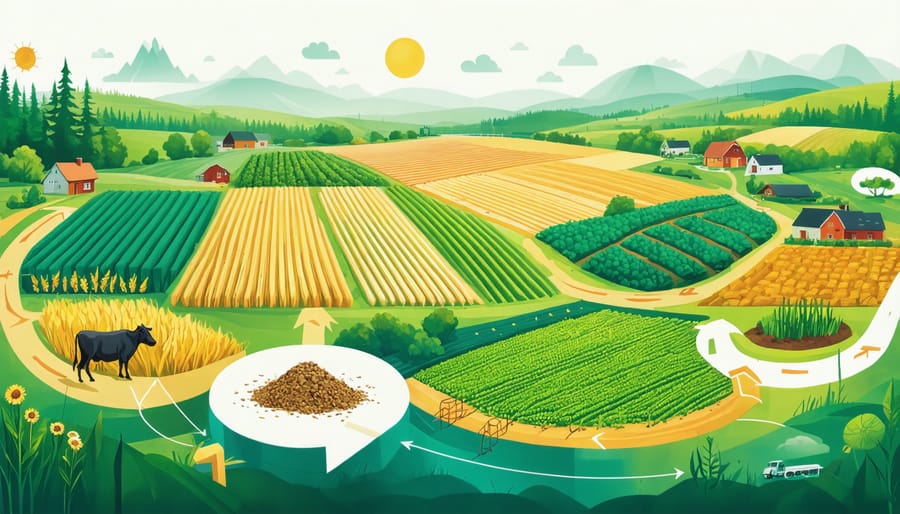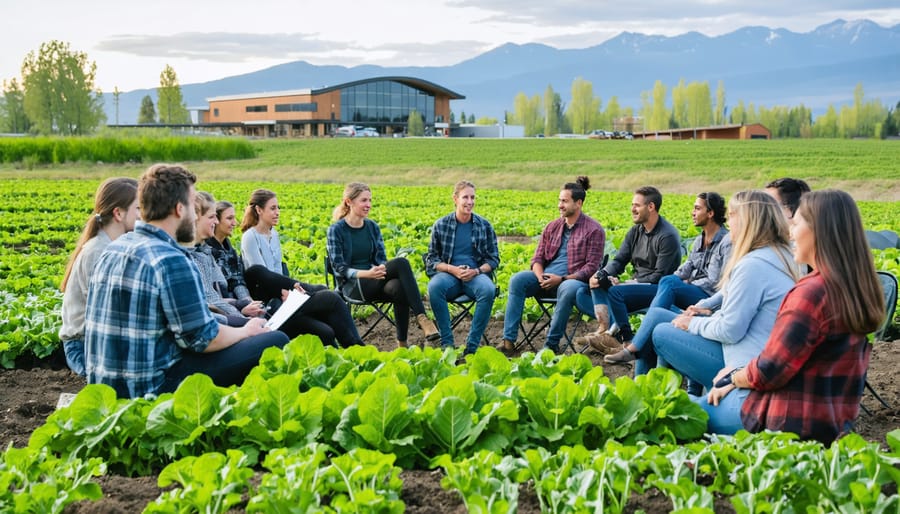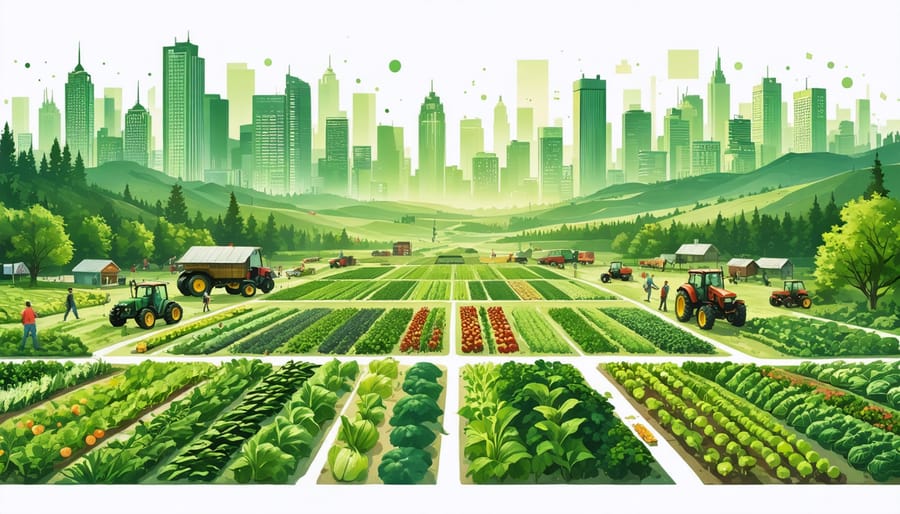In the heart of Alberta’s farming communities, a transformative partnership is reshaping the future of Canadian agriculture. Rural farmers and urban markets are forging powerful connections that extend far beyond traditional supply chains, creating a resilient food system that benefits both producers and consumers. These partnerships, built on direct relationships between family farms and city-based food businesses, have sparked a 40% increase in local food sales across the province over the past five years.
Rural-to-urban agricultural partnerships represent more than just business transactions – they’re breathing new life into small-scale farming while satisfying growing urban demand for traceable, sustainable food sources. From weekly farmers’ markets in Edmonton and Calgary to innovative digital platforms connecting remote producers with urban restaurateurs, these collaborations are revolutionizing how we think about food distribution in Canada.
The impact is clear: rural communities gain economic stability through guaranteed market access, while urban residents enjoy fresher, more sustainable food options. As climate change and food security concerns intensify, these partnerships offer a practical blueprint for building more resilient local food systems that support both rural vitality and urban food security.

Bridging the Rural-Urban Divide in Alberta’s Organic Sector
Market Access Challenges
Rural organic farmers face several key challenges when attempting to reach urban markets, particularly during the organic transition in Alberta. Transportation logistics often present the most significant hurdle, with farmers needing to coordinate efficient delivery routes across considerable distances while maintaining product freshness. Many small-scale producers struggle with the costs associated with refrigerated transport and storage facilities.
Meeting consistent supply demands can also be challenging, especially when dealing with seasonal variations and weather uncertainties. Urban retailers and restaurants typically require steady product volumes, which can be difficult for individual farmers to guarantee throughout the year.
Regulatory compliance and food safety certification requirements add another layer of complexity. While necessary for consumer protection, these standards can be costly and time-consuming for small operations to implement and maintain.
Marketing and relationship-building in urban environments require different approaches than traditional rural networks. Farmers must invest time and resources in developing their brand presence, understanding urban consumer preferences, and establishing connections with city-based buyers, all while maintaining their daily farming operations.
Success Stories from Alberta
The Organic Box, founded by Danny and Miranda Turner in Edmonton, stands as a shining example of successful rural-urban partnership. Starting with just a handful of local farmers in 2010, they now work with over 60 Alberta producers, delivering fresh organic produce to thousands of urban households weekly.
In Lethbridge, the Southern Alberta Food Partnership has bridged the gap between small-scale farmers and urban restaurants. Local farmer Sarah McKenzie doubled her revenue within two years by supplying directly to five downtown eateries, while reducing food transport distances by 80%.
The Innisfail Growers cooperative demonstrates the power of collective action. Five family farms joined forces to serve Calgary’s urban markets, sharing resources and distribution costs. Their weekly presence at Calgary farmers’ markets has increased their combined annual revenue by 45% since 2018.
Medicine Hat’s Farm-to-Table Initiative connected twelve local producers with urban school cafeterias, creating a sustainable food system that serves 5,000 students daily while ensuring stable income for participating farmers. This program has become a model for other Alberta communities seeking to strengthen rural-urban connections.
Building Sustainable Partnership Models
Direct-to-Consumer Programs
Direct-to-Consumer (D2C) programs have revolutionized how Alberta farmers connect with urban consumers. Community Supported Agriculture (CSA) programs create lasting partnerships between farmers and city residents, with members receiving weekly or bi-weekly boxes of fresh, seasonal produce throughout the growing season. These programs typically run from June to October in Alberta, offering shareholders a diverse selection of vegetables, fruits, and sometimes eggs or meat products.
Farmers’ markets have become vital community hubs across Alberta’s urban centres, with notable success stories in Edmonton’s Old Strathcona Farmers’ Market and Calgary’s Crossroads Market. These venues provide farmers with direct access to urban customers while offering valuable opportunities for relationship building and customer education. According to the Alberta Farmers’ Market Association, over 80% of market vendors report increased profitability through direct sales compared to traditional distribution channels.
Modern D2C programs have adapted to include online ordering systems and flexible pickup options, making local food more accessible to busy urban consumers. Some innovative Alberta farmers have implemented hybrid models, combining traditional CSA shares with à la carte market sales and restaurant partnerships. This flexibility helps farmers maintain steady income streams while reducing food waste and maximizing crop utilization.
For optimal success in D2C programs, farmers should focus on clear communication with customers, consistent product quality, and reliable delivery schedules. Many successful programs also incorporate educational components, such as farm visits or cooking demonstrations, strengthening the urban-rural connection.
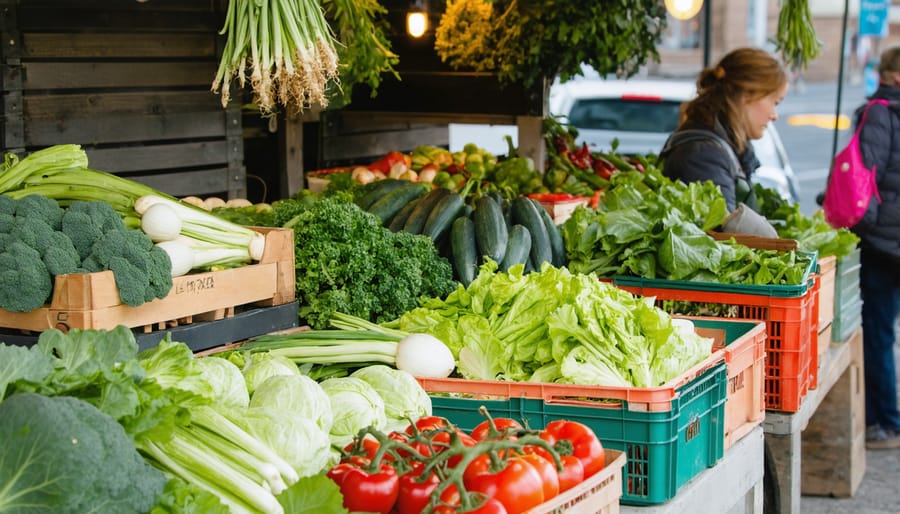
Urban Distribution Networks
Food hubs and cooperative distribution networks are revolutionizing how rural producers connect with urban markets across Alberta. These systems act as crucial intermediaries, pooling resources from multiple farms to create efficient supply chains that benefit both producers and consumers.
The Calgary Regional Food Hub serves as an excellent example, connecting over 40 local producers with urban retailers, restaurants, and institutional buyers. This hub provides cold storage, processing facilities, and coordinated delivery services, enabling small-scale farmers to access markets they couldn’t reach independently.
Cooperative distribution systems work by combining products from multiple farms into single shipment points, reducing transportation costs and environmental impact. For instance, the Central Alberta Co-op Network has helped its members reduce delivery costs by 30% through shared transportation and collective marketing efforts.
Modern food hubs often incorporate digital platforms for inventory management and order processing. The Edmonton Fresh Food Collaborative uses a cloud-based system that allows urban buyers to purchase directly from multiple rural producers through a single platform, streamlining the ordering process and ensuring consistent supply.
These networks also provide valuable services like quality control, packaging, and marketing support. Many Alberta food hubs offer training programs to help farmers meet urban market requirements and food safety standards. This collaborative approach has proven particularly beneficial for organic producers, who can share certification costs and access specialized marketing channels through these networks.
For farmers considering joining a distribution network, it’s essential to evaluate the hub’s service fees, delivery schedules, and market connections to ensure they align with your production capacity and business goals.
Technology Integration
Digital platforms are revolutionizing how rural farmers connect with urban consumers across Alberta and beyond. Through innovative digital farming partnerships, producers can now directly market their products to city dwellers using user-friendly apps and online marketplaces.
Local Food Box, a Calgary-based platform, enables farmers to list their available produce, while urban customers can browse and purchase items for weekly delivery. Similarly, the Farm-Link Alberta initiative has connected over 200 rural producers with urban restaurants and retailers through their digital marketplace.
These platforms typically include features like real-time inventory management, secure payment processing, and delivery scheduling. Many also incorporate tracking systems that allow consumers to trace their food’s journey from farm to table, building trust and transparency in the supply chain.
For farmers, these digital tools reduce the time and resources traditionally spent on marketing and distribution. Urban consumers benefit from convenient access to fresh, local produce and the ability to support regional agriculture directly. Some platforms even facilitate educational content sharing, where farmers can post updates about their growing practices and seasonal availability.
The success of these digital initiatives has inspired many Alberta farmers to embrace technology as a crucial component of their business strategy, leading to more sustainable and efficient rural-urban food networks.
Environmental Benefits of Local Partnerships
Carbon Reduction Metrics
Through careful monitoring and data collection across Alberta’s rural-urban partnerships, we’ve observed significant environmental benefits that directly impact our carbon footprint. Local farmers participating in these initiatives report an average reduction of 30% in transportation-related emissions compared to traditional distribution channels.
A recent study by the University of Alberta showed that direct farm-to-city partnerships reduced food transportation distances by an average of 1,500 kilometres per shipment. This translates to approximately 2.5 tonnes of CO2 emissions avoided per farm annually. When multiplied across the hundreds of participating farms in Alberta, the impact becomes substantial.
Collaborative distribution networks have proven particularly effective, with shared transportation routes cutting individual vehicle trips by 45%. Farmers markets and community-supported agriculture programs in Edmonton and Calgary have demonstrated that consolidating deliveries can save up to 3,000 litres of fuel annually per participating farm.
Beyond transportation, these partnerships have encouraged sustainable farming practices. Data from 2022 shows that partner farms increased their soil carbon sequestration by an average of 1.2 tonnes per hectare through improved cultivation methods. Additionally, urban waste composting programs linked to rural farms have diverted over 5,000 tonnes of organic waste from landfills, reducing methane emissions while providing valuable soil amendments.
These measurable outcomes demonstrate how local partnerships contribute meaningfully to Canada’s climate action goals while supporting our agricultural communities.
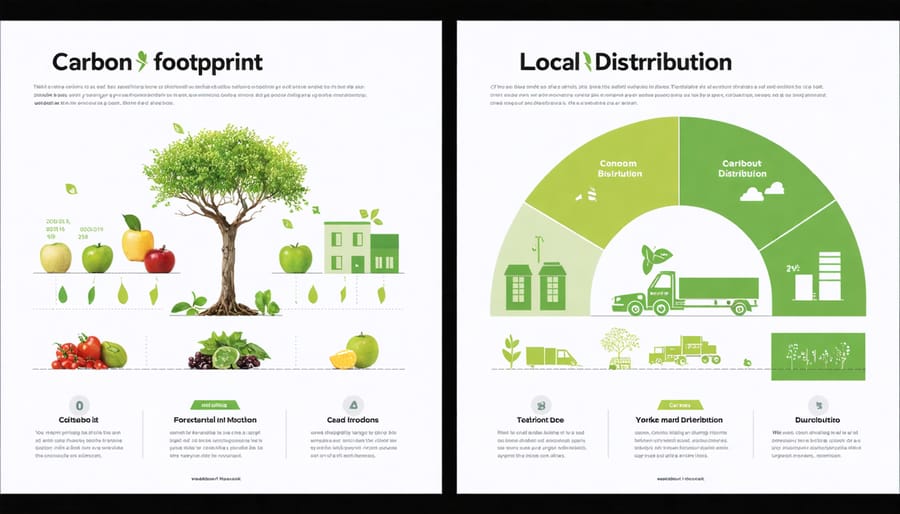
Soil Health Improvements
Sustainable farming practices implemented through rural-urban partnerships have led to significant soil health improvements across Alberta’s agricultural landscape. Farmers participating in these collaborative initiatives report increased organic matter content, enhanced water retention, and improved soil structure within just two to three growing seasons.
Local success stories, like the Red Deer Valley Regenerative Farm Network, demonstrate how urban funding and rural expertise combine to implement effective soil management practices. Their data shows a 30% increase in soil organic carbon levels and a 40% improvement in water infiltration rates over five years.
These improvements stem from practices such as cover cropping, reduced tillage, and crop rotation diversity – all supported by urban partners who understand the long-term value of soil health. Urban consumers’ willingness to pay premium prices for sustainably grown produce helps offset the initial costs of implementing these soil-building practices.
Monitoring programs, often funded through urban-rural partnerships, have documented decreased soil erosion, increased earthworm populations, and better nutrient cycling. These partnerships also facilitate knowledge sharing between experienced farmers and urban agriculture enthusiasts, creating a collaborative learning environment that benefits both communities.
The result is healthier soil that produces more nutritious crops while sequestering carbon and supporting biodiversity – a win-win situation for both rural producers and urban consumers.
Getting Started with Rural-Urban Partnerships
Initial Planning Steps
Before embarking on a rural-to-urban farming partnership, careful planning is essential for success. Start by assessing your current farming operation and production capacity, considering both your available land and potential for scaling. Document your growing practices, certification status, and seasonal production schedules to present clear information to potential urban partners.
Research your target urban market thoroughly, including demographic data, existing competition, and potential partnership opportunities with restaurants, farmers’ markets, and food cooperatives. In Alberta, many successful partnerships begin with connections to Calgary and Edmonton’s thriving food scenes.
Develop a detailed business plan that outlines your production costs, pricing strategy, and distribution logistics. Consider factors like transportation requirements, storage needs, and delivery schedules. Factor in the additional time and resources needed to maintain urban relationships and market presence.
Evaluate your infrastructure needs, including post-harvest handling facilities, cold storage, and packaging requirements. Many successful Alberta farmers recommend starting small and scaling gradually to manage risks and build sustainable relationships.
Create a communication strategy that includes both digital and traditional networking methods. Consider joining local agricultural associations and attending urban food industry events to build connections. Document your farming practices and story, as urban partners often value transparency and authenticity in their supplier relationships.
Finally, review relevant regulations and food safety requirements for selling in urban markets, ensuring compliance with all municipal and provincial standards.
Available Resources and Support
Several organizations across Alberta and Canada are dedicated to helping farmers establish successful rural-to-urban partnerships. The Alberta Farm Fresh Producers Association offers networking events, marketing resources, and support for organic farmers looking to connect with urban markets. Their mentorship program pairs experienced producers with newcomers to share insights and best practices.
The Canadian Agricultural Partnership (CAP) provides funding opportunities and technical assistance for farmers interested in developing direct-to-consumer marketing channels. Local agricultural societies throughout Alberta host farmers’ markets and community events, creating valuable networking opportunities between rural producers and urban buyers.
Regional food hubs, such as the Edmonton Food Hub and Calgary Regional Partnership, offer infrastructure support, including storage facilities, distribution services, and marketing assistance. These organizations help bridge the gap between rural producers and urban consumers while reducing logistical challenges.
The Organic Alberta organization provides specialized resources, including workshops, certification guidance, and marketing support specifically designed for organic producers. They maintain an active directory connecting farmers with urban retailers, restaurants, and consumers.
Additionally, municipal economic development offices often provide business planning assistance, market research data, and grant writing support to help farmers expand their urban market presence. Many offer regular workshops and networking events focused on strengthening rural-urban agricultural connections.
The path to successful rural-to-urban partnerships in Alberta’s agricultural landscape is both challenging and rewarding. By fostering these vital connections between our rural producers and urban markets, we strengthen our local food systems and build more resilient communities. Remember that successful partnerships start with clear communication, mutual understanding, and a shared commitment to sustainable practices.
Take the first step by reaching out to local farmers’ cooperatives, urban markets, or agricultural extension services in your area. The resources and support networks are in place – you just need to tap into them. Whether you’re a rural producer looking to expand your market reach or an urban partner seeking to strengthen local food connections, the time to act is now.
Together, we can bridge the rural-urban divide and create a more sustainable, profitable, and connected agricultural future for Alberta and beyond.

